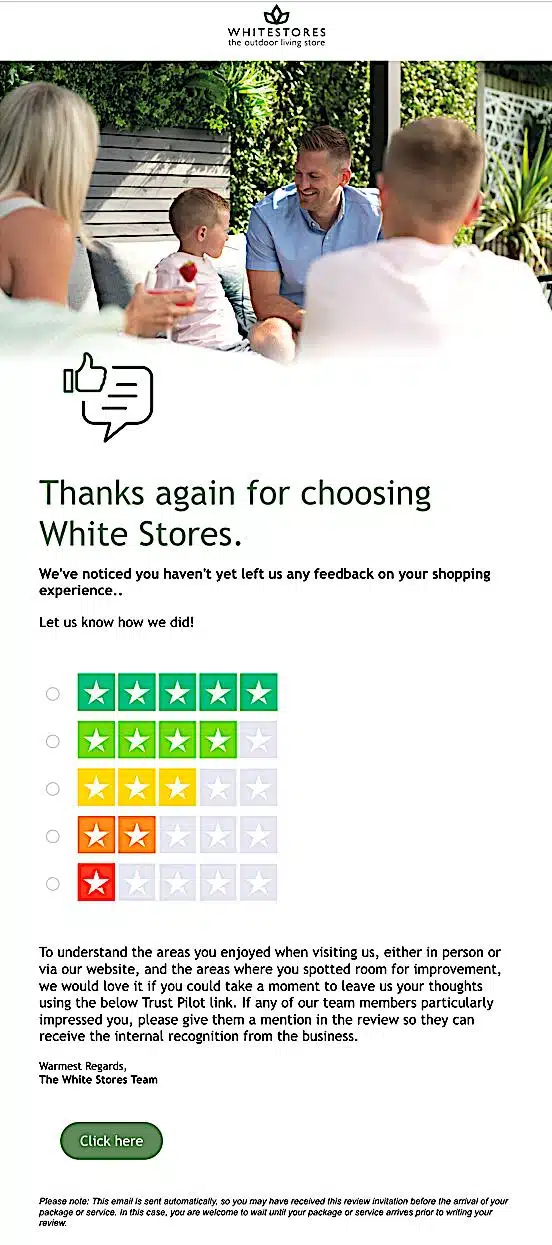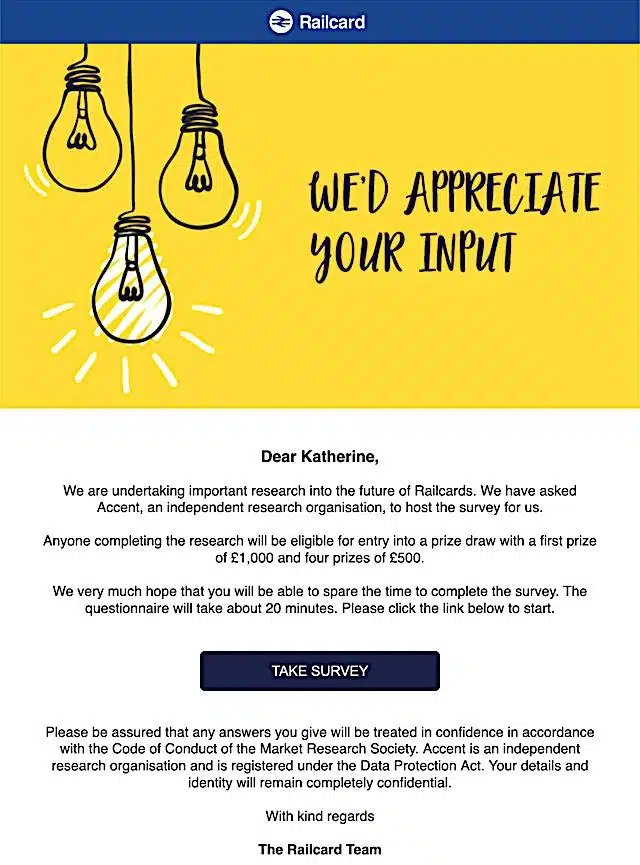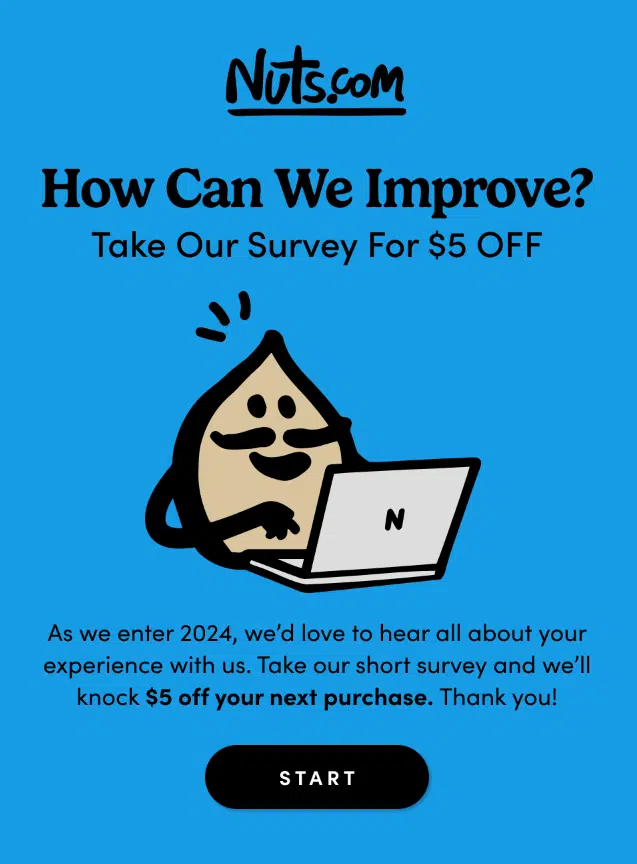Why it’s time to rethink your feedback emails and how to do it right
Use these tips to create more effective email surveys and review requests your customers will want to open and complete.
Which of the three statements below comes closest to your view when it comes to email surveys and review requests:
- A. Love ‘em! They’re useful, and we use the return data in our email program, customer profiles and product development
- B. Hate ‘em! We don’t get much helpful info from them and readers generally ignore them.
- C. Meh … They don’t do much for our email program, but we send them anyway to stay in the inbox and every once in a while, we get interesting comments.
Why am I asking? Because a recent debate in an online email marketing community over resending feedback requests like email surveys and purchase reviews got me thinking about broader issues.
Are survey and review requests worth the time it takes to create, send and analyze them? How could we do a better job with these familiar emails?
8 reasons why brands send surveys and review requests
Marketers are probably more curious to learn what other people are thinking than anybody else in your company. Since we can’t personally ask everybody who buys our products or uses our services, surveys are the most versatile and least expensive way to get the info we need.
Surveys fall into several general categories:
- General inquiries to assess the customer experience with our brands.
- Questions that address specific aspects of that experience, like brand attitudes, the purchase process or a service contact.
- Request to review a specific event, like a purchase, a product or a service contact.
We can come up with lots of reasons to send these feedback requests, too:
- It’s one way to find out what customers think about our brand, products and services and whether they’re happy, unhappy or even thinking about moving to another brand.
- We can use the data to assign net promoter scores to our customers who will most likely recommend us to their family and friends.
- Survey and review request emails keep our brand names in customer inboxes between campaigns.
- Once we have an optimized survey email template, we can send it several times throughout the year, either to the whole list or to targeted groups or automate it after a purchase.
- We can post positive reviews on our website, in emails and social posts and on review sites to promote ourselves through social proof and authority.
- Sending surveys shows our bosses we have ticked the “voice of customer” box if our companies are big into that research.
- Personal contacts through focus groups, telephone surveys and the like are more expensive.
- The boss told us to do it.
But something’s askew here. These are all legitimate reasons for sending emails. But what about the recipients? What’s in it for them? None of these reasons address that big question.
Dig deeper: How to ask customers for reviews (and actually get them)
What do customers think of feedback requests?
As a consumer, I’m not a fan. I usually ignore these emails. (Sorry, fellow marketers!) But I work with clients who rely on them and we do everything we can to make those emails persuasive and inviting.
Not everybody feels the way I do about feedback requests. However, I was surprised to see how that online discussion I mentioned above revealed I’m not the only marketer who deletes those requests.
We will always have people who want to express what they think, whether it’s positive or negative. But what do most people do with those survey and review-request emails?
To answer that question, I turned to eDataSource, a SparkPost company that tracks inbox placement and email engagement. Here’s what I found:
- Most of the feedback-request emails I surveyed found their way to the inbox. Big brands like Hilton, Delta, the NFL, Wayfair and AT&T generally had 100% inbox placement, while smaller or regional brands ranged from 0% to 60%.
- Read rates — the percentage of email opened and presumably read for several seconds before closing — ranged mainly from 0% to 30%, although some reached almost 70%. Airlines and financial-services companies had the highest read rates.
- Read rates often varied from one campaign to the next for the same brand. One streaming service saw a high of 78% on one campaign and a low of 8.3% on another.
When feedback requests go wrong
In general, people will be more motivated to take your surveys if they’re relevant, timely, short and easy to complete. Having a worthwhile incentive helps, too, especially if they don’t have to spend anything to redeem it.
Three problems can kill your response rates:
- Your timing is off, so your feedback request goes out before your customers receive their purchases, or it’s too soon for them to have an opinion of the product/service.
- You don’t give respondents a clear reason why they should take the time to fill out your survey or what you’ll do with the results.
- You send surveys to inactive or churned customers.
A broader issue can also doom your feedback requests: Not having a specific strategy. When you know why you want customer input, you can shape everything from email and form design to audience selection and how to use the data you gather — even whether you should send a survey at all.
Dig deeper: 8 major email marketing mistakes and how to avoid them
10 tips to send better feedback requests
If feedback requests like surveys and reviews are an important part of your email marketing program, these tips can help you increase your responses, acquire more and better data and put it to better use.
1. Audit your full purchase process from order confirmation to delivery
This can reveal where your email, CRM and fulfillment platforms might be incompatible. Besides showing where you could improve your purchase journey, it can highlight gaps or missteps, such as email timing.
2. Know why you’re sending that feedback request
It seems obvious to say this, but here goes: You need to know what you want to learn from your customers, so you need different surveys for different purposes, each with content and designs that support those purposes.
Your brief for creating a request email will define exactly what you want to learn from your customers.
- Do you want to uncover potential influencers? Send a survey asking how likely they are to talk to their friends and family about your company.
- Want feedback on your purchasing or booking processes? Ask them to evaluate different points in the journey and the entire journey itself.
- Did customers get what they wanted from their contacts with your customer support team? Ask them to rate their experience and satisfaction.
- Looking for customer reviews you can post on your website or in emails to encourage other customers to buy those products? Send a purchase review request.
3. Get the timing right
Your audit can show you where you might need to revise your purchase journey emails.
Earlier, I mentioned that bad timing can hurt response rates, especially for purchase review requests that arrive before the customer can try the product or service.
This happens more often than you might think. My review of purchase journeys in the MailCharts database found at least 10% of feedback requests went out before the delivery confirmation email.
If you send delivery confirmation emails, wait at least a week to give customers time to check their purchases and ensure the email was delivered as promised. Without a delivery confirmation, wait a minimum of two weeks after the item shipped before triggering the review request.
Consider waiting longer during business periods, such as the holidays, when high demand or bad weather can disrupt shipping schedules.
If you can’t easily coordinate message triggering with fulfillment, consider following White Stores’ example below. It asks customers to rate their shopping experiences with the brand, so it’s not a product review request.

Customers could easily ignore this request if it arrives before their purchases. So, White Stores deftly avoids that problem by assuring customers they can wait to fill out the review until after their packages arrive. The risk is that your customer will forget to do the survey, so a carefully worded follow-up might net a few more responses.
4. Select your audiences with care
This doesn’t mean you should only send surveys or review requests to the people most likely to give you five stars. But you’ll get more reliable feedback if you think about which request emails you send to whom, when and why.
- Send to a clean list. You don’t need to clear out all seemingly inactive subscribers or customers, but you don’t want to endanger your sender reputation or waste your time and money by sending to a dirty list.
- Hold back on review requests. A good reason to delay sending a feedback request is when someone has complained, canceled a service or returned a product. You’ll need tight integration with other platforms, especially your customer support, but this step is essential if you don’t want to irritate someone into writing a bad review.
5. Remember the ‘What’s in it for me?’ factor
Always tell people why you’re asking for their opinion. That’s a given. But don’t stop there.
Some people will fill out surveys or review products because they sincerely want to help other people. But altruism goes only so far. If you want to get the widest range of replies, not just from your biggest fans or perpetual complainers, show them what they can gain by answering.
Be as specific as possible. Explain how their comments will be used to improve a process, help you develop new products or allocate resources — whatever can help your company serve them better.
The email below from Railcard, a service of the UK’s National Rail, explains it is asking customers to comment on their experiences ostensibly to support a major initiative for the service.

6. Incentive or no incentive?
As part of the “What’s in it for me?” factor, your strategy and your budget should drive your decision whether to dangle an incentive to persuade more people to complete your feedback requests.
A classic offer is a 20% discount or cash applied against a purchase. But consider offering something that doesn’t take a direct hit on your profit margin. In other words, yes to freebies or extra loyalty points, no to discounts or money off on an order unless it’s sizable enough to make a difference.
The more you ask of your respondents, the more you will likely need to kick in to compensate for their time. Also, even the best incentive you can develop won’t compensate for a vaguely written or poorly designed survey form.
7. Make it as easy as possible to complete the survey
If you look back at the Whitestores example, you’ll see it uses a popular tactic: a simple scale the customer can use to pick an appropriate response. When you click on the scale it takes you to a landing page with the star rating already filled in.
Another way to take steps out of the process is to use AMP for email, which allows email users to convert directly from the email instead of clicking through to a landing page. This lululemon email lets respondents choose a rating, add some comments and submit the form, all in the inbox.

8. Use the right tone
As with all of your other emails, your feedback requests should use a tone that fits well with your brand and other email programs. As you look over the email examples I share here, you’ll see they have a variety of tones.
The Railcard example is quite formal, while the Dunelm email below has a more informal tone and one that skews toward encouraging positive reviews.
This tactic can be risky because someone less than enthusiastic about their experience might ignore the survey. That might net you more 5-star reviews, but you’ll lose out on feedback highlighting potential problems.

Nuts.com takes a different approach. Instead of skewing the copy toward positive experiences, it simply asks, “How can we improve?” That psychological twist might net more critical responses but also more useful ones.

9. Don’t ask for too much information at one time
Detailed surveys yield lots of information but most likely fewer responses. If your survey will be part of a major restructuring program, take an approach similar to progressive profiling, where you begin with a simple checkbox or scale with selected responses and then move on to more in-depth questions that require written answers.
The White Stores example above has a classic format that gives respondents the option to choose a star rating and then quit at the landing page or keep answering questions.
Dig deeper: Progressive profiling: Why it’s a win for you and your customers
10. Test, optimize, repeat
Whether you’re sending a one-time feedback request as part of a project or creating a template for a message that triggers after a purchase or customer-support contact, you’ll test and optimize the message before it goes live. But don’t stop there.
As with all your other triggered emails, you should check on them to ensure they trigger as planned and reflect your current branding. But you also should test them occasionally, especially if you see a gradual decline in engagement and responses.
Should you resend that feedback request?
That’s the question that touched off the recent debate among email marketers. My take: Weigh the potential annoyance factor against the possible gain of a few more responses. I’m not a fan because you’re putting much effort into enticing customers for potentially little gain.
However, if the powers that be compel you to reach a certain response rate, like 30% or even higher, you might have to go the resend route. In that case, treat the resend as you would a resend of a regular email campaign and double down on the altruism or the incentive if you offer one.
Opinions expressed in this article are those of the guest author and not necessarily MarTech. Staff authors are listed here.
Related stories

